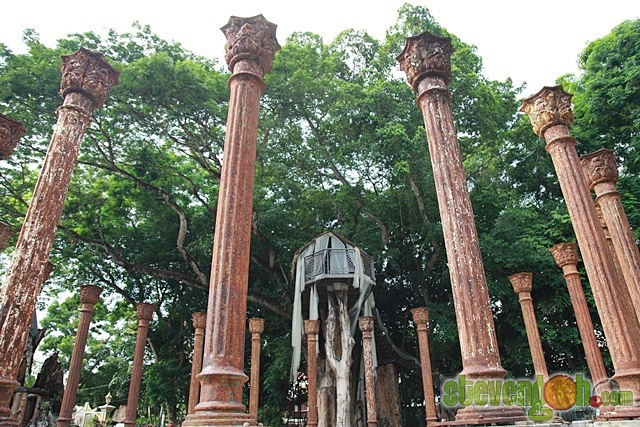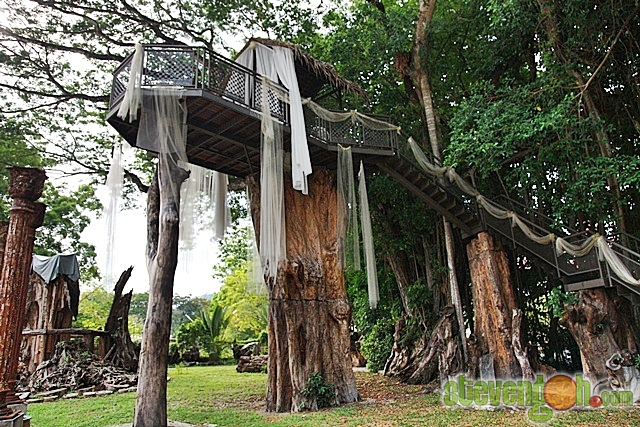Do you know that in the past during the British Colonial days in Penang, a bag of cloves is equivalent to a bag of gold? Do you realise that David Brown is a high stake Poker Player? Are you aware that the renowned founder of Eu Yan Sang is actually a Penangite?

Colonial Penang Museum is the place that answers all the questions that you wish to know about the other side of Penang history that is usually unknown to the public. The museum exhibits the unique lifestyle of both the British Administrators and the wealthy merchants in Penang. This Museum is located at Jalan D.S. Ramanathan, Pulau Tikus.

This extraordinary collection has been amassed in over 50 years by the founder of Colonial Penang Museum. This Museum is housing over 1,000 colonial-era artifacts, and they are currently owned by the Ma family.
Just before entering the museum, there are 22 pieces of Roman Pillars in the middle of the compound. The pillars are worth a fortune. Just behind the pillars is a very creepy-looking tree house, perhaps due to the hanging white cloths that made it look slightly spooky.

The admission fees for this museum is RM30 (Adult), RM15 (Child) for Foreigners and RM20 (Adult), RM12 (Child) for Mycard holders.
Upon entering this museum, you will be welcomed by a 19th Century White Carrara marble statues by renowned artist Atelier R. Bigazzi Florence. White Carrara marble is the pride of the Apuane Alps. It is one of the famous ornamental stones all over the world. Due to taking photo portraits was not well-known in those days, the rich people usually requested the artists to carve sculptures in resemblance of their beloved as remembrance.
The reverse painting glass has been made as the glass of the main door. This artifact itself is already worth the price of an entry-level car.
A sailing ship that was made of cloves. Thousands of clove had been used to create the masts and rigging, the wheelhouse, shipboard and even the sailors. In Britain’s 17th and 18th centuries, this ship that was made of cloves was worth a fortune as during that time cloves were worth at least their weight in gold.
The bronze lion is a symbolic status and grace for those holding high posts. The eyes of the lion are made of gold.
These two reverse paintings were from William Morris & Co. He was an English textile designer, artist, writer and socialist associated with the Pre-Rahphaclite Brotherhood. William Morris’s artwork in glass are widely admired by artists, sought by collectors and praised by critics.

The porcelain baby dolls collection. These dolls are hard to find now. However, these are just a small part of the owner’s mass collection.
Erard Piano by Francois Linke Circa, 1905. A fantastic quality piano in early 20th century. The Louis XV-style gilt floral-bronze-mounted marquetry six-legged lion paw feet grand piano has natural (white) keys which were made of ivory and the black keys were made of Ebony wood. There are only 2 pieces of this piano globally.
The Baba and Nyonya tables and chairs used in weddings. In those days, the bride and groom had to sit separately during the wedding ceremony. The round table is for the groom while the oval table is for bride. The table of the groom will be higher by 1 inch which means that the groom will have the final say in all family matters.

Hubert Mcgoldrick (1927) was born in Rathgar, Dublin. He gained an award in 1932 Aonach Taiteann competition for his opus sectile stations of the Cross St. Mary’s Church, Westport. Below is the reversed painting by him. Usually these types of glass paintings can only be found in churches. But for these pieces in the museum, they are not related to religion and hence they are very valuable and usually can be found in those highly-affluent homes. There is someone who is willing to buy these 2 paintings for USD 1.5 million from the owner.

The table and armchairs are from C. Lazarus Co. Cabinet makers of Calcutta c.(1874). The table and armchairs are made for the Indian Muslim family. For the gentlemen, the chairs will come with arm rest whereas the ladies’ is without arm rest as they usually will sit with their hands on their lap. However, the width of the chairs for the ladies are bigger in consideration of their bell-shaped dresses.
The rectangular-framed lighting with 6 light bulbs. This was specially designed for used on top of the 6-holed snooker table. In those days, only noblemen were able to play this game and ladies were forbidden.
This marble table was made into the shape of “Penang” island, which it never occurred to me that it looked like one.
This handwritten letter shows Captain Francis Light was the founder of Penang and Georgetown in 1786. On behalf of British East India Company, he leased Penang island from Abdullah Mukarram Shah of Kedah Sultanate and renamed it as Prince of Wales Island and Georgetown as its capital. Of course, the one displayed here is just a photocopy. The real copy was kept in a secured place by the owner.
This oval-shaped container looks like a mini spaceship, but actually works as a food warmer for those people in the olden days. In those days, husbands worked till late and wives would prepare food well beforehand and kept them in the container to preserve the temperature of the food.
David Brown (1778 – 1825) was a pioneer nutmeg planter, major spice planter and merchant in Penang. He has also successfully experimented in cloves cultivation. However, many of us didn’t know that he is a high-stake poker player as he has a fold-over poker table in his mansion during that time.
The chair that was previously seated by the Japanese General is also being displayed here. The difference of this chair compared to the Chinese version is the Sun at the center of the chair and the three claws covering the Sun shows that this chair is a General’s chair.
Have you seen the Bird of Paradise? The awareness of the bird of paradise was in the 16th century, after merchants returned from Indonesia. The wings and feet had been removed and as such some Europeans thought that the birds did not have feet and spent their lives floating through the air, drinking dew and never touched the earth until they die. Therefore, the name of this bird is called Bird of Paradise.
A rare bisque bathing dolls circa 1920 by the German firm of Galluba and Hoffman. Her gorgeous face is decorated in typical Galluba style, with beautiful complexion, finely-feathered one stroke brows, intaglio blue eyes. One thing that is very interesting is their hair are made from real human hair.
Harpsichord, is also known as stringed keyboard. This instrument is made from strings that were plucked to produce sound. It was developed in Europe in the 14th and 15th century. It is rare to find this type of instrument now.
Eu Tong Sen, the founder of Eu Yan Sang was a leading businessman in Malaya, Singapore and Hong Kong during the late 19th and early 20th century. A lot of people didn’t realise that he was a Penangite. The marble chair and table was bought here from his mansion as you can spot his initial “ETS” on the chair.

Even this marble bathtub with a beautiful European girl sculpture by the side was once his favourite woman.
There is a hidden meaning of this carving on the table below. If you managed to read until here and you still don’t know the answer, please PM me and I will reveal the answer.
The gift from those days are really meaningful. This ship is actually given as a gift to a merchant.
“Kapitan” in the local way of saying “Captain”. This is the hat of a Kapitan.
These are pieces of “lost and found” porcelain. Each piece comes with a certificate of authenticity and they are the one and only pieces in this world and now they are being sold as souvenirs.
The beautiful Buddha head made from iron can be located in the garden.
In the garden you can find the last piece of the collapsed Angsana Tree in Penang. This British era’s Angsana Tree collapsed due to thunder storm at the Padang Polo Road in front of the Penang General Hospital on 28th April 2013. The tree was then transferred to this museum for memories.
Besides that, they have built a majestic tree house on top of the trees. There is a table and some chairs on the tree house but too bad no coffee or tea is served. Otherwise it will be a unique place to relax and have some tea.
Kids just love tree houses.
Overall, this is an eye-opener and a place to gain additional knowledge where you won’t find in school textbooks. After coming to this museum, I realized that we as Penangites have missed out so much history of Penang in the past.
Admission Fees (non-Mycard):
- Adult – RM30
- Child – RM15 (Age 5 -12)
Admission Fee (Mycard):
- Adult – RM20
- Child – RM12 (Age 5 – 12)
Operation hours: 9:30am – 6:30pm (daily)
Contact: 04-228 8561/ 012-528 8005
Address: No 7, Jalan D.S. Ramanathan, Pulau Tikus Penang.
GPS: 5.429122,100.306222




























expensive le
Pamela, if you are looking for the additional and something that you don’t know it is worth the money. But if you already know the facts, it will be not worth.